Layers and their properties
Last updated: 2025-10-17
Total video time: 29:42
 Layer basics
Layer basics
Exercise files: acad-data-c3d20.zip
Start with acad-layr-prprtis-begin.dwg
Layers in AutoCAD are used to control object display properties, visibility, plotting, object selection, and organization. All objects in a drawing will reside on a Layer. The Layer an individual object resides on is known as the Object Layer. When AutoCAD objects are created, they will be placed on the Current Layer. You can set which Layer is the Current Layer either through the Ribbon Layer Panel or Layer Properties Manager. Some of the most commonly used/edited Layer properties are On/off, Isolate/unisolate, Freeze/thaw, Lock/unlock.
Civil 3D objects are made up of components. For example, an Alignment can have Line, Curve, Spiral, and/or other components. The object and it's components can all be on unique layers. When Civil 3D objects (i.e. Alignments, Corridors, Surfaces) are created, they will be placed on the default Object Layer specified in the Drawing Settings dialog.
An optional Layer name wildcard can be included that will append the default Object Layer name with the name you give to the Object. In this way, a new Layer will be created for each named Civil 3D Object created. For example, the default Object Layer for Alignments in the WisDOT design template is P_ALI_*. The * character is the wildcard. If an Alignment is named HWY 14, the default Object Layer created will be P_ALI_HWY 14.
- Open acad-layr-prprtis-begin.dwg
- Ribbon > Home tab > Layers panel
- Observe Current Layer = E_ALI
- Change Current Layer to E_ALI_CPI
- Layer of an object can be changed in the Properties palette.
- Application menu dropdown > Drawing Utilities > Drawing Settings > Object Layers tab
-
Observe default Civil 3D Object Layers
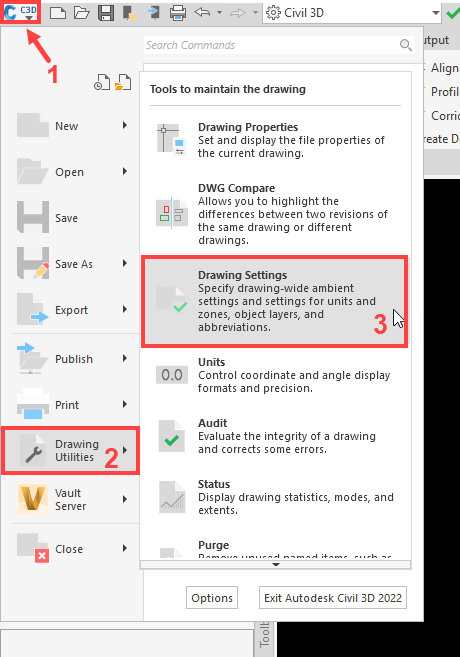
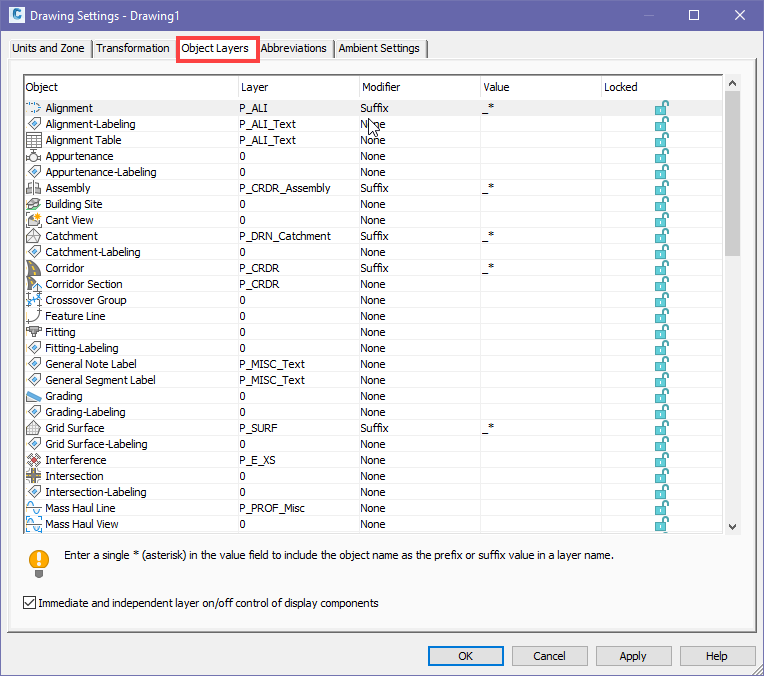
Info: The Ribbon Layer Panel dropdown shows the Current Layer if no object is selected. It shows the selected Object Layer if an object is selected.
-
- Select BOTTOM OF MEDIAN Line on right side of SECTION A-A detail
- Ribbon > Home tab > Layers panel dropdown
- Observe Object Layer = P_XS_FinalBorrow
- Ribbon > Home tab > Layers panel dropdown
- Select BOTTOM OF MEDIAN Line on right side of SECTION A-A detail
- Ribbon > Home tab > Layers panel > Make Current
- Properties palette > General
- Observe Object Layer = P_XS_FinalBorrow
- esc
- PLINE enter
- Ribbon > Home tab > Layers panel dropdown
- Observe Current Layer = P_XS_FinalBorrow
- Draw Polyline with two vertices anywhere between SECTION A-A and SECTION B-B details
- Ribbon > Home tab > Layers panel dropdown
- Select any other polyline
- Ribbon > Home tab > Layers panel > Make Current
- Observe that Current Layer changes accordingly
- Ribbon > Home tab > Layers panel > Make Current
 Layer commands: off, freeze, isolate, lock
Layer commands: off, freeze, isolate, lock
Start with acad-layr-prprtis-begin.dwg
Commonly edited Layer properties
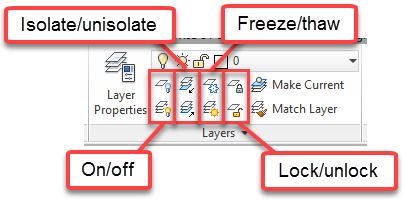
| Layer property | Description |
|---|---|
| On/off |
When a Layer is turned off, objects residing on that Layer will not display, although they will be accounted for when processing object display, such as when you Zoom Extents or Regen. |
| Isolate/unisolate |
Depending on Layer settings, Layer Isolate will either Lock and fade display or turn off all Layer except those of selected objects. |
| Freeze/thaw |
When a Layer is frozen, objects residing on that Layer will not display and will not be accounted for when processing object display. Freezing a Layer with an extraordinarily large number of objects can help drawing performance. |
| Lock/unlock |
Objects on a locked Layer cannot be deleted or edited. Locking Layers can be helpful when you wish to use objects on a Locked Layer for visual reference or to snap to while also protecting alteration of the geometry. |
On/ off
- Continue working in acad-layr-prprtis-begin.dwg
-
Ribbon > Home tab > Layer panel > Off
- Select an object on the layer to be turned off
- Select multiple objects below SECTION A-A detail
-
esc

- Double-click middle mouse wheel
- Observe Zoom Extents is still accounting for Layers turned off
-
Ribbon > Home tab > Layer panel > Turn All Layers On
Freeze/ thaw
- Continue working in acad-layr-prprtis-begin.dwg
-
Ribbon > Home tab > Layer panel > Freeze
- Select an object on the layer to be Frozen
- Select multiple objects below SECTION A-A detail
-
esc

- Double-click middle mouse wheel
- Observe Zoom Extents not accounting for frozen Layers
-
Ribbon > Home tab > Layer panel > Thaw All Layers
Isolate/ unisolate
- Continue working in acad-layr-prprtis-begin.dwg
-
Ribbon > Home tab > Layer panel > Isolate
- Select an object on the layer to be Isolated
- Select BOTTOM OF MEDIAN Line on right side of SECTION A-A detail
- enter
- Observe non-isolated Layers fade and lock
-
Ribbon > Home tab > Layer panel > Isolate
- Select an object on the layer to be Isolated or Settings
- Off
- This will turn non-isolated layers off rather than fading and locking them.
- Off
- Select an object on the layer to be Isolated or Settings
- Ribbon > Home tab > Layer panel flyout
-
Adjust Locked Layer Fading with slider
-
-
Ribbon > Home tab > Layer panel > Unisolate
Lock/ unlock
-
Ribbon > Home tab > Layer panel > Lock
- Select an object on the layer to be Locked
- Select BOTTOM OF MEDIAN Line on right side of SECTION A-A detail
- enter
- Observe Locked layer display fade
- Hover cursor over object on locked Layer
Observe "padlock" glyph indicating the Layer is locked

- Ribbon > Home tab > Layer panel > Unlock
-
Select an object on locked P_XS_FinalBorrow Layer
-
 Layer properties manager: interface & editing
Layer properties manager: interface & editing
Start with acad-layr-prprtis-begin.dwg
The Layer Properties Manager is where you can sort, create and delete Layers or edit Layer properties such as Layer name, description, display color, visibility (on/off or freeze/thaw), plot style name (how thick a lines will plot), whether the Layer will plot or not, etc. Take advantage of shift+select and ctrl+select to affect multiple Layers at once.
- Continue with acad-layr-prprtis-begin.dwg
- Ribbon > Home tab > Layer panel > Layer Properties
- Observe "366 total Layers" listed along bottom of Layer Properties Manager palette
- Observe the layer filters on the left side of the palette.
- Notice that the columns width can be adjusted for readability.
-
Set a Layer Current by selecting a row and clicking the Set Current button
 or double-clicking a row in Layer Properties Manager
or double-clicking a row in Layer Properties Manager- Layer Properties Manager
Observe Status = Current
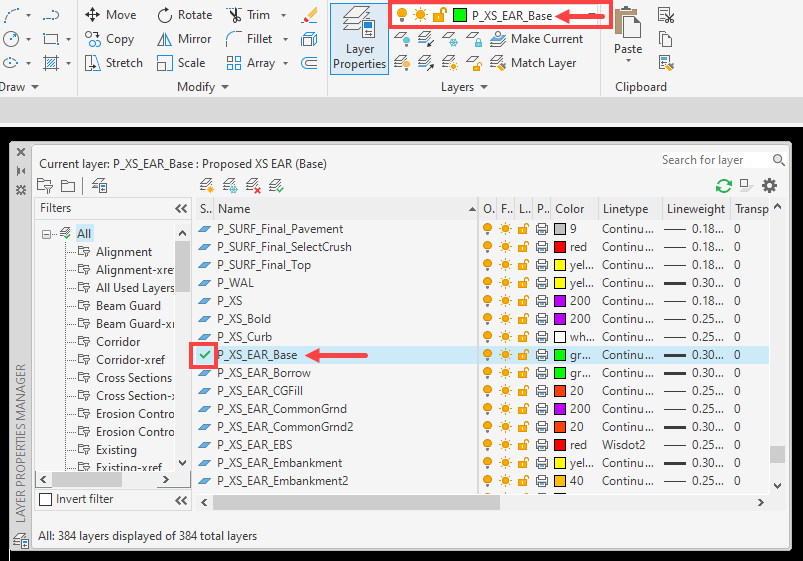
- Layer Properties Manager
- Select a row in by left clicking
Left click once more on the Layer name to edit the name
Left click elsewhere in to cancel or finish the name edit
- Toggle Layer Off
- "The current layer will be turned off. What do you want to do?"
Turn the current layer off

- "The current layer will be turned off. What do you want to do?"
- Toggle Layer On
- Toggle Layer Freeze
- "This layer cannot be frozen because it is the current layer."
Close

- "This layer cannot be frozen because it is the current layer."
- Toggle lock
- Observe Layer display fade in Model Space
- Color column
- Click on color of any layer
- Observe list of colors
- Cancel
- Click on color of any layer
- Linetype column
- Click on linetype of any layer
- Observe list of linetypes
- Cancel
- Click on linetype of any layer
- Lineweight column
- Click on lineweight of any layer
- Observe list of lineweights
- Cancel
- Click on lineweight of any layer
- Plot column
- Toggle plot/ noplot
- Plot Style column
- Click on any named Plot Style
- Observe list of Plot Styles
Cancel
Warning: In pre-2018 WisDOT drawings, Named plot styles have been assigned intentionally to Layers included in the WisDOT design template. These Plot Styles dictate the plotted color (i.e. Black), linetype and lineweight of plotted objects. Do not change these assigned Plot Styles as doing so will result in non-uniformity among plotted WisDOT plan sets.
- Click on any named Plot Style
- New VP Freeze column
Toggle New VP Freeze
Info: New VP Freeze affect creation of new Viewports. Viewports are used for plan production to "look" from your plan sheet Layout (Paper Space) into your Civil 3D model (Model Space). The concepts and use of Layouts, Viewports and Paper Space vs Model Space will be covered in more depth in later training modules.
- Layer Properties Manager
- Right-click any column header
- Maximize all columns
- Right-click Name column header
- Freeze column
Observe static display of Name and Status Column while scrolling left-right

- Freeze column
- Right-click any column header
 Layer properties manager: create new & layer notification
Layer properties manager: create new & layer notification
Continue with acad-layr-prprtis-begin.dwg
- Continue with acad-layr-prprtis-begin.dwg
- Layer Properties Manager
- Select E_ALI row
- Create New Layer
Layer name = E_ALI2
Info: When creating a new Layer in the Layer Properties Manager, all properties of the selected Layer other than the Layer name will be assigned to the new Layer created.
Requirement: When creating a new layer, follow the WisDOT Layer naming convention. For example, E_ALI_<object name> ("E for existing or P for proposed"_"three or four letters for object type"_"optional additional sections of three or four letters for object type"_ "object name or description")

- Select E_ALI2
- Right-click > Merge selected layer(s) to...
- Select E_ALI
- OK
- "The selected layers will be merged into layer E_ALI. Do you want to continue?"
- Yes
- Right-click > Merge selected layer(s) to...
- Layer Settings
- New Layer Notification = checked
- Evaluate new layers added to drawing = checked
Evaluate all new layers = filled

- Select E_ALI
- Create new Layer
- Right click newly created Layer 1
- Reconcile Layer
 Layer properties manager: properties filter & settings
Layer properties manager: properties filter & settings
Continue with acad-layr-prprtis-begin.dwg
Layer Properties Filters essentially query all the Layers in your drawing based on Layer name text or other Layer properties. This allows you to reduce the Layers listed in Layer Properties Manager, making Layers easier to find and work with. You can also use the search field in the upper right corner of Layer Properties Manager to filter the Layers shown based on Layer name. Using Layer Settings, you can also apply the current Layer Properties Filter to the Ribbon Layer Panel dropdown list.
- Continue working in acad-layr-prprtis-begin.dwg
- Layer Properties Manager
- Filters
- Alignment
- Observe reduced list of Layers displayed in Layer Properties Manager
- Observe Layer quantification note in lower-left of Layer Properties Manager window

- Right-click Alignment Layer Filter > Properties
- Observe Layer Filter Properties name-based query

- Right-click All Used Layers Filter
Observe inability to modify properties or delete this filter

Info: The All Used Layers Filter is one of the default Layer Filters automatically created in any drawing. These default Layer Filters cannot be modified or deleted. Additional default Layer Filters include External Reference, Non-External Reference, Unreconciled Layers and Viewport Overrides.
Info: When Layers are referenced by a Civil 3D Style included in a drawing or template, the Layers are included in the All Used Layers Filter and cannot be deleted. This is true even if there are no Civil 3D objects in the drawing. For example the Alignment Civil 3D Style layers are included in the WisDOT design template even before any Alignments are created.
- Alignment
- Filters
-
Layer Properties Manager > New Property Filter
Info: Layer Filters using Name filtering can use a * as a wildcard on either end of the name to capture unique layer names that fit the layer filter criteria.
 Layer states & layer walk
Layer states & layer walk
Continue with acad-layr-prprtis-begin.dwg
Layer states
A Layer State is a saved version of the way a drawings Layer properties are set up. The properties saved in a Layer State include Layer On/ off, Freeze/ thaw, Lock/ unlock, Color, Linetype, Lineweight, Transparency, Plot style, Plot/ no plot, New VP Freeze and VP Freeze. Layer States can be imported, saved from the current Layer Properties setup, or restored in a drawing at any time. Restoring a Layer State will reset all Layer properties currently set in a drawing to those saved in the Layer State. Use Layer States to quickly and accurately switch to a desired Layer properties setup for specific design, external referencing, or plotting workflows. Some key Layer States are included in the WisDOT design template and on the Ribbon WisDOT Standards tab. The Layer States on the WisDOT Standards tab can be imported through the Layers Tool Palette.
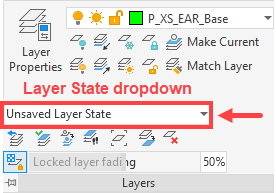
- Continue working in acad-layr-prprtis-begin.dwg
- Ribbon > Home tab > Layers panel flyout > Layer State dropdown > New Layer State
- New layer state name = color
- OK
- Layer Properties Manager
- Shift+select all Layers
- Click any Layer Color field
- Color = red
- OK
- Ribbon > Home tab > Layers panel flyout > Layer State dropdown > New Layer State
- New layer state name = Red
- OK
- Ribbon > Home tab > Layers panel flyout > Layer State dropdown > Color
- Observe all Layer Color properties restored based on color Layer State
- Ribbon > Home tab > Layers panel flyout > Layer State dropdown > Red
- Observe all Layer Color properties changed to red
Layer walk
The Layer Walk command allows you to sort and select Layers from a list or your drawing area and see them displayed in real time. You can use Layer Walk to efficiently select a group of Layers either by name or by selecting objects in the drawing area, then create a Layer State based on that selection from within the Layer Walk dialog. The Layer State created from within the Layer Walk command will only affect visibility through the Layer on/ off property. All other properties will remain unchanged.
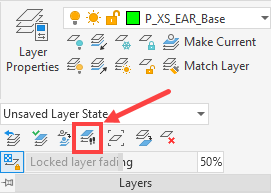
- Ribbon > Home tab > Layers panel flyout > Layer Walk
- Layer Walk dialog
- Right-click in Layer list
- Select all
- Observe Layers displayed in drawing area
Select only P_XS_Final Borrow
- Right-click P_XS_Final Borrow
- Save Layer State
- New layer state name = Layer State
- OK
- Save Layer State
- Right-click P_XS_Final Borrow
- Close
- Right-click in Layer list
- Layer Walk dialog